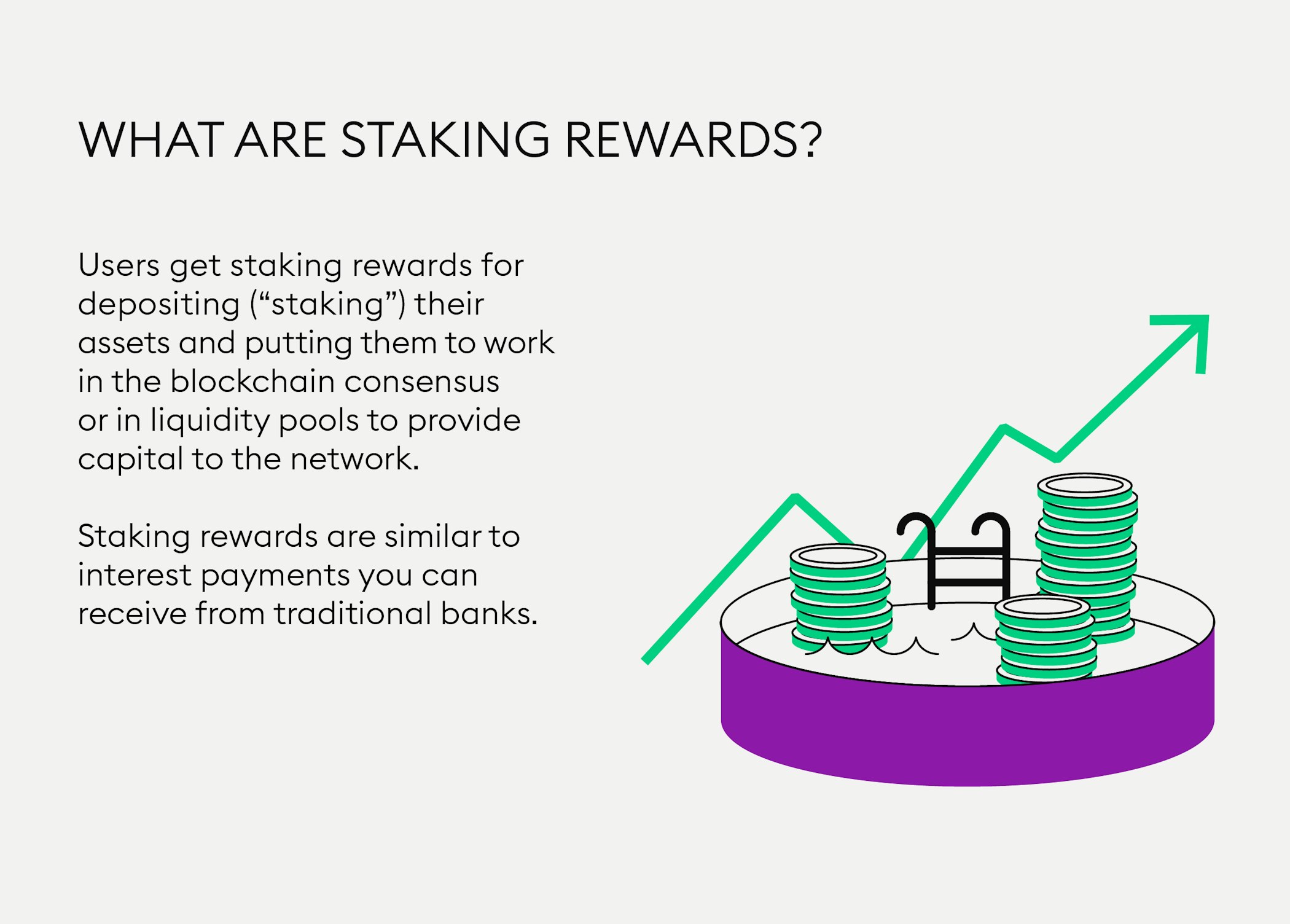
Staking rewards - what are they?
Cryptocurrency holders can earn rewards in the form of staking rewards by staking their coins in a proof of stake (PoS) network or delegating them to a staking pool.
Through crypto staking, holders of cryptocurrencies can receive rewards for providing certain cryptocurrencies without needing to trade them.
Any crypto holder who stakes coins into a staking pool can act as a validator and earn the right to add a new transaction to a blockchain.
The amount of staking rewards depends on the number of participants staking, the transaction volume, and other factors.
It's important to research a coin and be aware of the possible risks before starting to stake.
What are staking rewards?
Crypto holders can stake part of their coin holdings by joining a staking pool to support the security of the network for a certain period. This means they tie their tokens to the network behind a coin. In return, they receive staking rewards, which represent an attractive return on their investment.
With crypto staking, investors earn rewards and income by providing certain coins or tokens, such as Ethereum or Cardano, without needing to trade actively. This process, which is part of the proof of stake consensus mechanism, allows them to profit in the form of staking rewards by staking their coins. By contributing their coins to a staking pool or staking them in the network, crypto holders can act as validators. This gives them the right to add new transactions to a blockchain.
New to Bitpanda? Register your account today!
Sign up hereThe amount of staking rewards depends on several factors, including the number of participants staking and the transaction volume. However, before deciding to stake, it's crucial to thoroughly research the specific coin and be aware of the potential risks.
We've summarised what staking rewards are, how they are generated and calculated, and the risks associated with staking rewards.
In-depth: The concept of staking
The term "staking" refers to "putting something at stake" – in this case, coins or tokens. In the world of cryptocurrencies, this means depositing a portion of your coins into a staking pool for a set period. This is a core component of the proof of stake consensus mechanism.
The reason cryptocurrency holders "stake" their coins in a staking pool within a network is that, in return, they receive a portion of the staking rewards that the staker or pool earns as a reward. This is similar to interest payments on savings in the traditional financial world.
While many crypto projects pay out staking rewards in the native tokens or coins of the network, other blockchains have created their own coins and separate tokens, which are used both for rewards and for the network's internal operations.
How are staking rewards generated?
Cryptocurrency holders can receive rewards in the form of staking rewards by staking their coins in a proof of stake (PoS) network or delegating them to a staking pool.
Staking rewards fluctuate based on the number of participants staking, transaction volume, and other factors. Once participants have deposited their coins into a staking pool to support validation, they gain the right to add new transactions to the blockchain. The number of tokens held will determine which node is allowed to validate a transaction.
When a validator is chosen and validates the transaction according to the network's rules, rewards are automatically paid out to that validator. In the case of a staking pool, the pool distributes a portion of the rewards to the cryptocurrency holders who delegate their coins. If a transaction is invalid or the chosen validator is offline, they must pay a penalty calculated as a percentage of their stake.
Lock-in period restriction
After a crypto investor chooses a staking pool and decides to delegate their coins, they can delegate their coins to the pool by activating the staking function in a specialised staking wallet.
Many projects require coin holders to "lock in" their holdings for a predefined period. Tokens are tied up during staking, meaning they cannot be withdrawn from a wallet or smart contract during this time. This presents a staking risk: coins that are locked cannot be sold during this period, even in the event of high volatility, which can come with sharp price increases or declines.
Which coins offer the highest staking rewards?
These are some cryptocurrencies currently (January 2024) offering some of the highest staking rewards:
The staking rewards that can be generated annually as potential profit varies depending on the coin's market capitalisation, with around five percent for coins with large market caps and over fifty percent for smaller projects. You can estimate potential rewards with approximate yield calculations using a reward calculator.
What is the annual percentage rate (APR)?
When calculating staking rewards, it's essential to understand several key terms. One commonly seen term is "APR" or "annual percentage rate." As the name suggests, the APR refers to the interest rate for an amount, expressed as an annual rate. In this case, it indicates how much interest is earned on an invested amount over one year.
If a loan is taken out, the APR indicates how much interest accrues on the borrowed amount over a year. This is called simple interest, applied when the amount is paid out or repaid after a year.
What is the annual percentage yield (APY)?
The "annual percentage yield" or “APY”, also known as the absolute interest rate, represents the interest rate, including compound interest, earned on an investment in one year. When researching staking rewards, keep in mind that APR and APY figures are calculated while considering liquidity, price fluctuations, and other factors.
How high are staking fees?
Staking fees vary depending on the cryptocurrency, staking platform, and chosen settings. They can range from a small percentage of staking rewards (for example, 1-5%) to higher fees, especially if third-party services or staking pools are used.
If you join a staking pool or stake through brokers or exchange platforms, you typically need a minimum coin balance to participate. When calculating potential staking profits, remember that transaction fees, like those for using staking pools, will also apply. These fees include charges for staking your tokens and deductions from your rewards by the pool before you receive them. Pool operators also regularly receive a share of the transaction fees and newly minted tokens when they run their node in full compliance with the consensus.
With Bitpanda Staking, you benefit from simple and transparent fees and processes for your crypto investments.
Frequently asked questions about staking rewards
What are validators and delegators?
The process of validation in a proof of stake (PoS) network involves processing, confirming, and writing transactions into a new block on the blockchain. In a peer-to-peer network, a computer node chosen to validate a new block is called a "validator."
Since each staking pool increases its chances of being chosen as a slot leader and validating the next block by pooling assets, staking pools look for delegators to participate in staking in exchange for a share of the rewards.
What are the risks of staking rewards?
As with all cryptocurrencies, there are risks involved as market fluctuations can potentially impact expected profits – and staking is no exception. Volatility can affect staking results so there is no guarantee and price fluctuations must be accounted for. This is particularly relevant when staking in a project where your coins are locked for a specific time, and you cannot sell them – even if the price drops. As a result, staking rewards may seem minimal compared to potential losses.
Furthermore, it’s important to be wary of the growing number of fraudulent projects and scams in the crypto space. If a project asks you to send your tokens to suspicious websites or wallets, promising unusually high APR or APY staking rewards, proceed with caution – such offers are often too good to be true. Moreover, non-compliant actions during staking can result in you being held accountable for the improper use of your staked assets.
What is an epoch in staking?
An epoch in staking refers to the duration of a reward cycle within a staking network, with all payout dates marked on an epoch calendar.
In the case of Cardano (ADA), for example, an epoch corresponds to about five days. However, there are much shorter epochs, such as in Ethereum (ETH), where an epoch lasts just 6.4 minutes.
What is an epoch slot leader?
Each epoch is divided into smaller time units called "slots," with each slot lasting one second – so an epoch of five days consists of 432,000 slots, and on average, a node is expected to be nominated every 20 seconds. The nominated node is called the "epoch slot leader" – if it produces a valid block, it is added to the blockchain, while other candidate blocks are discarded.
Further topics on staking
Are you interested in understanding more about staking? Our detailed articles provide further insights into the world of staking and show you what really matters.
This article does not constitute investment advice, nor is it an offer or invitation to purchase any digital assets.
This article is for general purposes of information only and no representation or warranty, either expressed or implied, is made as to, and no reliance should be placed on, the fairness, accuracy, completeness or correctness of this article or opinions contained herein.
Some statements contained in this article may be of future expectations that are based on our current views and assumptions and involve uncertainties that could cause actual results, performance or events which differ from those statements.
None of the Bitpanda GmbH nor any of its affiliates, advisors or representatives shall have any liability whatsoever arising in connection with this article.
Please note that an investment in digital assets carries risks in addition to the opportunities described above.
